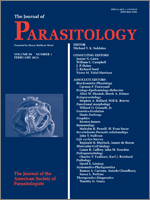Increasingly frequent outbreaks of zoonotic infections call for studies of wildlife parasites to reach a better understanding of the mechanisms of host switch, leading to the evolution of new diseases. However, speciation processes have been insufficiently addressed in experimental parasitology studies, primarily due to difficulties in determining and measuring mate-recognition signals in parasites. We investigated patterns of sexual process and ookinete development in avian Haemoproteus (Parahaemoproteus) spp. (Haemosporida, Haemoproteidae) using in vitro experiments on between-lineage hybridization. Eleven mitochondrial cytochrome b (cyt b) lineages belonging to 9 species of hemoproteid were isolated from naturally infected passerine birds. The parasites were identified to species on the basis of morphology of their gametocytes and polymerase chain reaction amplification of segments of the cyt b gene. Sexual process and ookinete development were initiated in vitro by mixing blood containing mature gametocytes with a 3.7% solution of sodium citrate and exposing the mixture to air. Ookinetes of all lineages except Haemoproteus payevskyi (lineage hRW1) and Haemoproteus nucleocondensus (hGRW1) developed; the 2 latter species did not exflagellate. Between-lineage hybridization was initiated by mixing blood containing mature gametocytes of 2 different parasites; the following experiments were performed: (1) Haemoproteus pallidus (lineage hPFC1) × Haemoproteus minutus (lineage hTURDUS2); (2) H. pallidus (hPFC1) × Haemoproteus tartakovskyi (hSISKIN1); (3) Haemoproteus belopolskyi (hHIICT3) × Haemoproteus lanii (hRB1); (4) Haemoproteus balmorali (hSFC1) × H. pallidus (hPFC1); (5) H. belopolskyi (hHIICT1) × Haemoproteus parabelopolskyi (hSYBOR1); (6) H. tartakovskyi (hHAWF1) × H. tartakovskyi (hSISKIN1); (7) H. pallidus (hPFC1) × H. lanii (hRB1); (8) H. tartakovskyi (hHAWF1) × H. parabelopolskyi (hSYBOR1). We report 4 patterns of between-lineage interactions that seem to be common and might prevent mixing lineages during simultaneous sexual process in wildlife: (1) the blockage of ookinete development of both parasites; (2) the development of ookinetes of 1 parasite and blockage of ookinete development of the other; (3) selective within-lineage mating resulting in ookinete development of both parent species and absence of hybrid organisms; (4) absence of selective within-lineage mating resulting in presence of ookinetes of both parents and also development of hybrid organisms with unclear potential for further sporogony. The present study indicates directions for collection of source material in the investigation of mechanisms of reproductive isolation leading to speciation in these parasites. The next steps in these studies should be the development of nuclear markers for distinguishing hemosporidian hybrid organisms and the experimental observation of further development of hybrid ookinetes in vectors.
How to translate text using browser tools
1 February 2013
Further Observations on In Vitro Hybridization of Hemosporidian Parasites: Patterns of Ookinete Development in Haemoproteus Spp.
Gediminas Valkiūnas,
Vaidas Palinauskas,
Asta Križanauskienė,
Rasa Bernotienė,
Rita Kazlauskienė,
Tatjana A. Iezhova
ACCESS THE FULL ARTICLE

Journal of Parasitology
Vol. 99 • No. 1
February 2013
Vol. 99 • No. 1
February 2013




